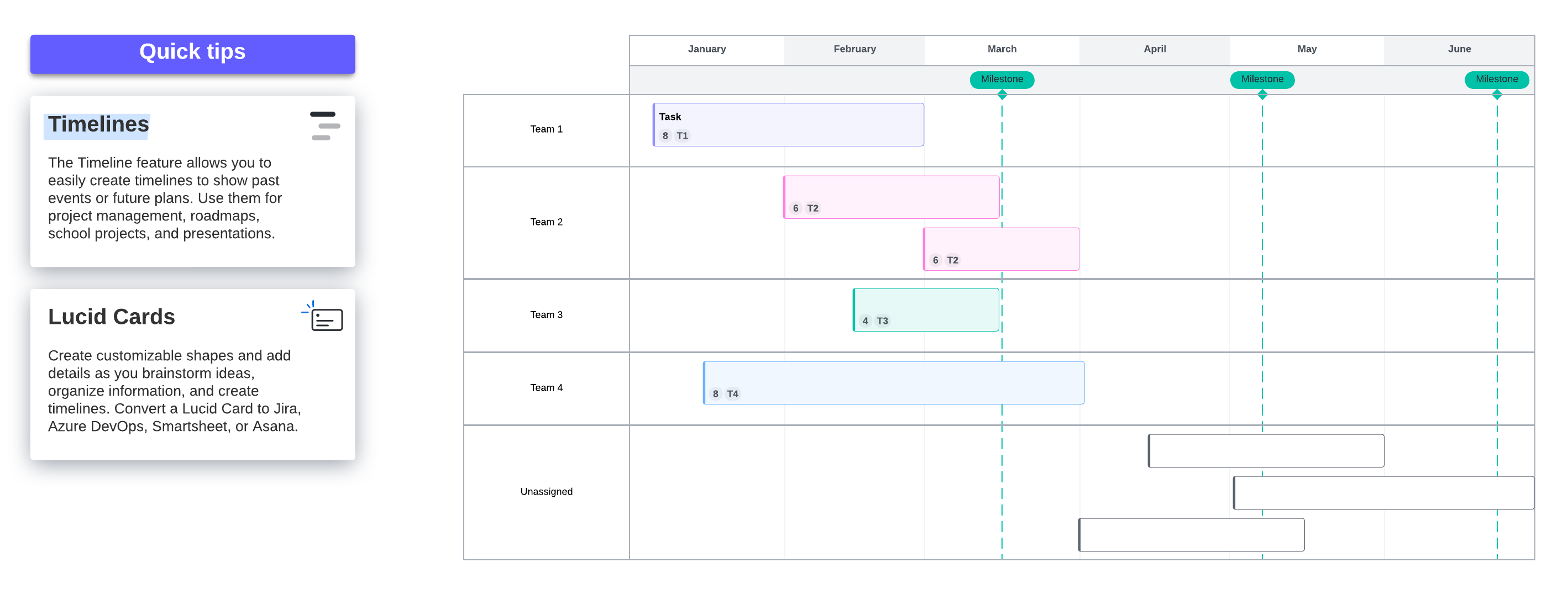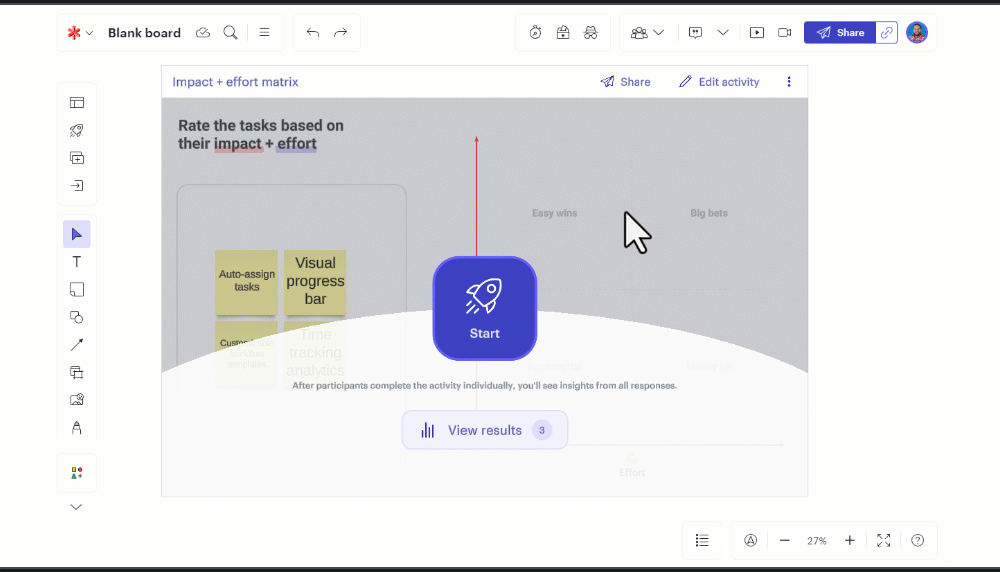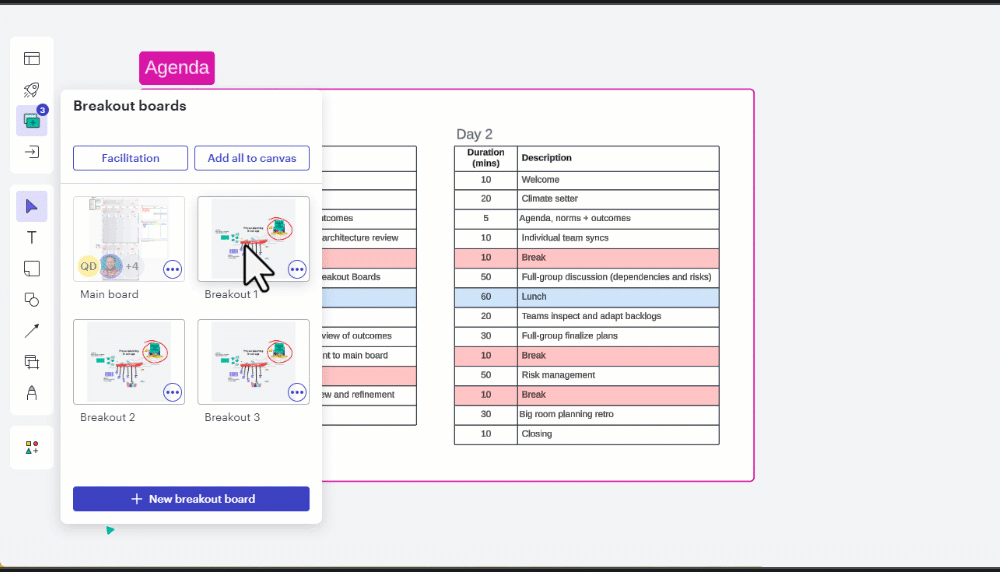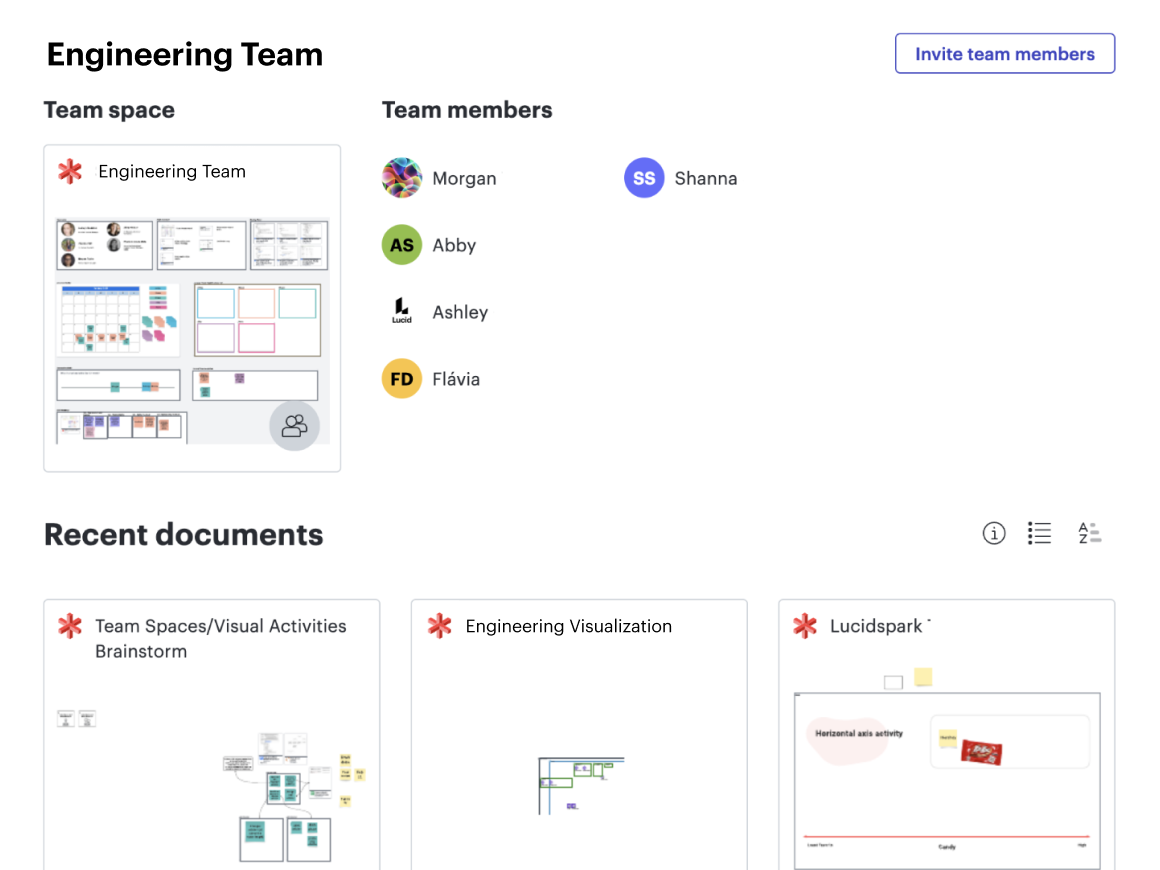
Digital transformation examples: How Lucid has helped companies around the world drive change
Reading time: about 9 min
Topics:
Key takeaways:
-
Digital transformation involves a fundamental shift in an organization’s operations to visualize workflows, streamline collaboration, and drive growth.
-
Visual collaboration solutions such as Lucid are essential for digital transformation since they enable clarity into work processes and enhance alignment across teams.
-
Companies around the world have used Lucid to facilitate virtual meetings, centralize online documentation, plan cloud migration, and enhance alignment.
Many businesses have moved their operations online and started using digital tools. Where companies often get stuck, however, is developing a plan for exactly how they’ll implement their digital transformation strategy or scale it across the organization.
According to a report by the Boston Consulting Group, about 90% of companies are undergoing some type of digital transformation, but only 35% succeed in achieving their transformation goals
This struggle is why businesses around the world have turned to Lucid for their digital transformation. Lucid helps companies digitize their processes, but it doesn’t stop there; Lucid also helps companies develop, manage, and maintain transformation for long-term success.
Keep reading for real-world examples of how Lucid has supported businesses from a variety of industries in their digital transformation strategies.
Why visual collaboration is key to digital transformation
Digital transformation isn’t just about moving tools and processes from physical to digital. True digital transformation involves a fundamental shift in operating systems to create value for customers and drive growth. From collaborating virtually to storing data in the cloud to AI adoption, there are many ways—and reasons—to go digital.
Using a visual collaboration solution like Lucid to visualize plans, workflows, systems, and architecture is an essential aspect of digital transformation. Visualization also enhances cross-functional alignment and provides more clarity to inform decision-making.
To successfully digitize, businesses need the following core competencies:
-
Alignment around goals, action plans, and priorities
-
Clarity into existing systems and processes
-
Strategic, data-informed decision-making
-
Resiliency so teams are able to adapt with confidence
-
Business agility across teams and workflows
Lucid supports businesses in developing all of these core competencies. And the good news is, any company in any industry can undergo digital transformation. Whether organizations need to map out their existing processes or increase overall agility, Lucid helps them get started and scale change across the business.
How Lucid has helped drive change: Successful digital transformation examples
Check out the following examples to see how Lucid has supported global businesses in driving successful change.
Digital transformation in software
Many organizations prioritize digital transformation to support their hybrid workforce. Lucid helped a financial software provider streamline their digital transition while increasing engagement and efficiency.
The company used Lucid to facilitate a hybrid capacity planning event that allowed it to map out its biggest cross-functional programs. The event involved teams from every area of the business and participants from across the globe. By using Lucid’s virtual whiteboard, participants were able to effectively collaborate and build alignment, whether they were onsite or remote.
A team of analysts at this software company also used Lucid to asynchronously brainstorm ideas for their roadmap, then organize those ideas into an actionable timeline. In this process, they created a single source of truth for their team. The team used facilitator tools in Lucid and the Jira cards integration to speed up their brainstorming process.

The impact:
-
Employee participation during resource planning sessions increased from 25% to 100%, and the organization saved 18 hours of preparation work before each event.
-
By replacing meetings with asynchronous collaboration, analysts saved 10 hours of time during each of their roadmapping exercises.
Digital transformation in the insurance industry
Digital transformation can help companies increase alignment around goals and action plans. For example, before an insurance agency adopted Lucid, it faced challenges with fragmented communication and low engagement, which led to missed deadlines, delayed decision-making, and confusion around responsibilities.
Now, with Lucid, the agency has benefited from a dynamic, centralized platform that promotes seamless collaboration. Teams used Lucid to foster continuous improvement and drive excellence in their Agile and planning processes.
The infrastructure Scrum master at the agency leveraged Lucid’s Visual Activities to align the 10 technical operations teams he oversees. By engaging in interactive, fun activities, these teams were more productive, gained clarity faster, and stayed on track with ease.

Lucid also became the go-to hub for the agency’s Agile director, simplifying communication and accelerating progress across the engineering and architecture teams. The company has saved countless hours and significantly improved the accuracy of its project tracking and reporting.
The impact:
-
Lucid saved Agile teams 100+ hours per person per year, resulting in an annual saving of $300,000 in productivity hours.
-
Collecting feedback asynchronously reduced time spent in meetings, saving the organization 48 hours per month on average.
Digital transformation in the public sector
A team at a state agency needed a more efficient, up-to-date recordkeeping system. The team used Lucid to track ownership status and automate key aspects of its workflow, entirely eliminating previous delays in recordkeeping since Lucid updates automatically.
By integrating JQL queries with Lucid, the team generated diagrams that showed the ownership status of water resources within the agency’s district. Using conditional formatting helped team members instantly understand ownership status, preventing errors or duplicate work. With hundreds of monthly requests across thousands of records, Lucid helped the team enhance efficiency and streamline ownership management.
In another example of digital transformation in the public sector, a national public health agency needed to digitize and standardize a specific protocol that involved decision trees. To create and scale this protocol, teams at the agency used Lucid for asynchronous collaboration and reduced feedback on testing processes from six months to one month. They could communicate layers of meaning in their Lucid boards with colors, fonts, and shapes, which wasn’t achievable in the previous pen-and-paper protocol documentation format.
The impact:
-
A team at a state agency reduced request processing time from 11 hours per request to 2.5 hours, cutting processing time by 77% and saving 170 hours per month.
-
Teams at a national public health agency reduced the time it took to diagram protocol from four hours to 15 minutes, allowing them to be 4x more efficient.
Digital transformation in the pharma industry
Again, digital transformation involves an entire operational shift to drive growth and increase value for customers. A top global pharmaceutical company needed to make this shift in order to evolve its five-year strategy, and Lucid was their solution for transformation. Multiple teams at the company adopted Lucid for everything from event planning to collaborating with customers to hosting brainstorming sessions.
IT leaders facilitated hybrid ideation sessions with Lucid, using breakout boards to break larger groups into smaller ones for more productive conversations. Thanks to data linking, the IT team could trust that their Lucid documents contained the most up-to-date information as they developed their team strategy.

The diagnostics team at the pharmaceutical company used Lucid’s intelligent diagramming capabilities to enhance collaboration with customers and help customers visualize how their solutions could work together. The team was able to customize each workflow in Lucid, maintain real-time documentation, and ensure consistency in usage.
The impact:
-
The diagnostics team measured a 65% increase in customer knowledge retention after implementing custom workflow builders in Lucid.
-
The events team saved 100 hours by consolidating all of their planning in Lucid and creating a reusable event template.
Digital transformation in logistics
One of the key competencies of digital transformation is strategic, data-informed decision-making. The architecture team at a top logistics company chose Lucid to support their global strategy, using Lucid to structure their workflows and accelerate their review process.
By leveraging team hubs, custom classification, and revision history, architects documented their work as a living blueprint that matched their governance policy and reinforced their ways of working. Their Lucid boards had powerful integrations and features like conditional formatting and Dynamic Tables that allowed architecture leaders to quickly identify blockers that may impact their KPIs.

A different global logistics company chose Lucid to drive transformation initiatives after using a variety of collaboration solutions. Lucid provided a more seamless and unified approach to planning, eliminating the need to switch between different tools, and it reduced cognitive overload for employees. Lucid’s universal canvas enabled the company’s digital team to transition smoothly from brainstorming to executing to monitoring progress, all within a single board. Centralizing documentation this way improved workflow management.
The impact:
-
The architecture department at a top logistics company was 6x more efficient with Lucid, saving 20 hours per week by accelerating meeting preparation and keeping meetings on time.
-
By using Lucid to visualize and track progress, the digital team at a global logistics company saved 14 hours during OKR planning.
Digital transformation and cloud migration
A growing cloud transformation organization needed to modernize to stay competitive. The organization also needed a solution to create numerous diagrams for a major documentation project.
After using Figma in the past, the company decided to standardize on Lucid due to Lucid’s ease of use, scalability, and collaboration capabilities.
In Lucid, they created process diagrams and system landscapes with custom shape libraries, aligning formerly siloed teams. The company not only accelerated its documentation efforts but also ensured long-term consistency and collaboration, making Lucid an indispensable piece of their modernization strategy.
In another example, a power tool manufacturer needed a solution for planning cloud migration that would also streamline team collaboration. Cloud architects at the company used Lucid to document existing cloud infrastructure, then plan migration and changes. The team saved days of work by being able to visualize the infrastructure and make revisions as needed.
The impact:
-
Solution architects at a cloud transformation organization worked 5x faster by using Lucid to document information. They reduced the time spent on document creation from three to four hours to just 30 minutes by using Lucid’s templates.
-
By switching to visual team planning, the infrastructure team at a power tool manufacturer saved 360 hours of meetings each quarter.
Use Lucid for your company’s digital transformation
Whether you’re looking to digitize work processes, centralize documentation, or shift to virtual collaboration, Lucid is indispensable for digital transformation. The companies listed above are just some of the organizations around the world that have turned to Lucid to plan, scale, and maintain their digital transformation strategies. If you need a way to start or manage your own transformation, check out Lucid today to get started on implementing large-scale digital change.

Accelerate your digital transformation
Reimagine and build a new way to do business with Lucid.
Get in touchAbout Lucid
Lucid Software is the leader in visual collaboration and work acceleration, helping teams see and build the future by turning ideas into reality. Its products include the Lucid Visual Collaboration Suite (Lucidchart and Lucidspark) and airfocus. The Lucid Visual Collaboration Suite, combined with powerful accelerators for business agility, cloud, and process transformation, empowers organizations to streamline work, foster alignment, and drive business transformation at scale. airfocus, an AI-powered product management and roadmapping platform, extends these capabilities by helping teams prioritize work, define product strategy, and align execution with business goals. The most used work acceleration platform by the Fortune 500, Lucid's solutions are trusted by more than 100 million users across enterprises worldwide, including Google, GE, and NBC Universal. Lucid partners with leaders such as Google, Atlassian, and Microsoft, and has received numerous awards for its products, growth, and workplace culture.
Related articles
Developing a digital transformation strategy for the future (+ templates)
Develop your digital transformation strategy to better prepare your company for the future. Get templates to help drive your strategy for digital transformation.
A guide to business process digitalization
Read our how-to guide on digitalizing your business to keep pace with the changing world of modernization.
How 5 public sector orgs are accelerating modernization and boosting efficiency with Lucid
Read how five public sector agencies and contractors have increased efficiency, accelerated IT modernization, and reduced costs with Lucid.
6 ways to use Lucid for your organization’s cloud initiatives (with real-world examples)
Check out the top ways Lucid has helped organizations accomplish their cloud initiatives.
